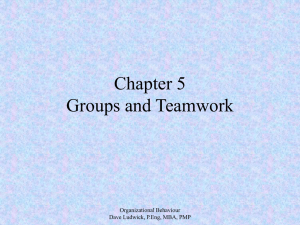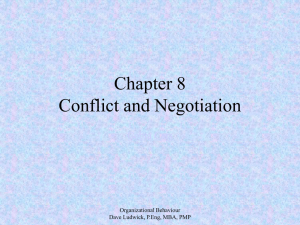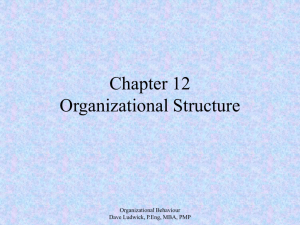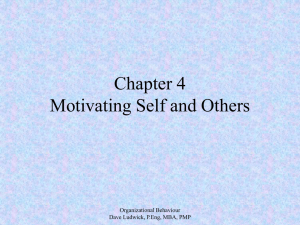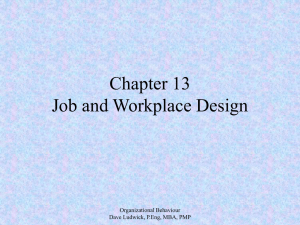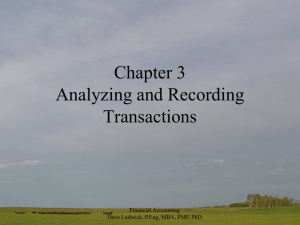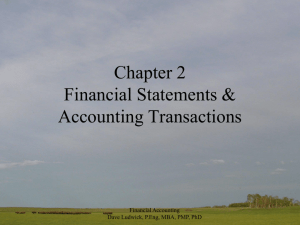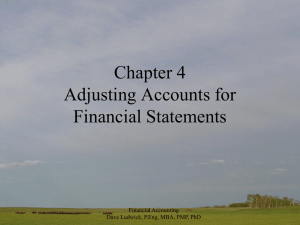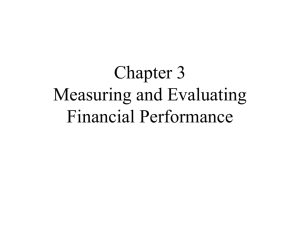Organizational Culture
advertisement
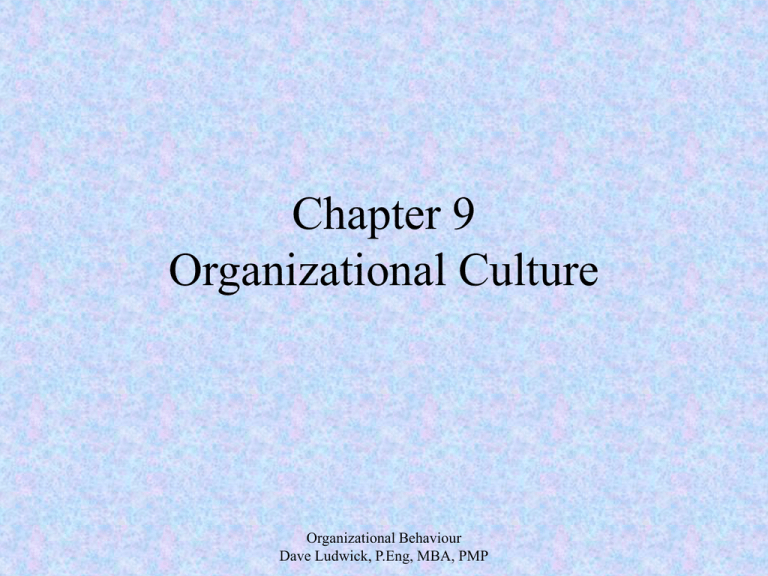
Chapter 9 Organizational Culture Organizational Behaviour Dave Ludwick, P.Eng, MBA, PMP What’s Organizational Culture? • Mintzberg says “Culture is the soul of the organization – the beliefs, values and how they are manifested. I think the structure is the skeleton. The culture gives the life force”. • Carter McNamara says “Basically, organizational culture is the personality of the organization. Culture is comprised of the assumptions, values, norms and tangible signs (artifacts) of organization members and their behaviors.” Organizational Behaviour Dave Ludwick, P.Eng, MBA, PMP Culture Defined • Organizational Culture – the pattern of shared values, beliefs and assumptions considered to be the appropriate way to think and act – It is shared by the members of the organization – It helps to solve and understand the things it encounters – Culture is taught to new members as a time tested framework for behaviour in the organization • Artifacts – aspects of the culture you can se, hear, touch, feel. How employees learn about the culture • Beliefs – Understandings of how objects and ideas related to each other • Values – the stable, long lasting beliefs about what is important Organizational Behaviour Dave Ludwick, P.Eng, MBA, PMP Characteristics of an Org Culture • Innovation and risk taking – the degree to which employees are encouraged to be innovative • Attention to Detail – The degree to which employees are expected to work with precision • Outcome Oriented – The degree to which management focuses on results rather than techniques • People Oriented – The degree to which management decisions take into account outcomes on people • Team Oriented – The degree to which activities are organized around teams vs individuals Organizational Behaviour Dave Ludwick, P.Eng, MBA, PMP Characteristics of an Org Culture • Aggressiveness – The degree to which people are aggressive and competitive vs easy going or supportive • Stability – The degree to which organization activities emphasize the status quo vs growth • On a day-to-day basis, cultural can be characterized by – Hours of operation, coffee breaks or not, flexible lunch times • Corporate Culture Meets GAP Adventure Video Organizational Behaviour Dave Ludwick, P.Eng, MBA, PMP Artifacts of Culture • Artifacts are the aspects of the organization that you can see, hear, touch and feel – They are the tools used by newcomers to learn about the organization • Stories – are artifacts that tell tales about the founders, previous employees, successes, failures – They anchor the present in the past nd provide explanations and legitimacy for current practices • Rituals – repetitive sequences of activities that express and reinforce the key values, such as identifying who the important people and what the important goals are. • What is an example of a organizational ritual? Organizational Behaviour Dave Ludwick, P.Eng, MBA, PMP Artifacts of Culture • Material symbols often act as an indicator to culture – Size of offices, dress code, executive perks, convey to employees who is important and the kind of behaviour that is appropriate • Members learn to use the proper language to be indoctrinated into the culture (language is evidence that a Background of Relatedness is present) Organizational Behaviour Dave Ludwick, P.Eng, MBA, PMP Cultures and Subcultures • Large organizations not onl posses cultures but can also exhibit subcultures • Dominant Culture – expresses the core values that are shared by a majority of the organization's members, giving it a distinct personality • Subcultures – tend to develop to reflect common problems, situations or experiences by a subgroup – Subcultures appear in geographically dispersed organizations, or where departments are large enough to have theirn own life force outside the organization’s Organizational Behaviour Dave Ludwick, P.Eng, MBA, PMP Birth and Life of a Culture • Cultures are born based on the personality and philosophy of the founder and earliest employees – Often, stories of the early company when it only had a few employees are the foundation for the culture – These early stories influence the thoughts and behaviours of the employees – Founders hire and keep those who think the way they do – They socialize new employees to the way they think and founders’ actions act as a role model for new employees – Everybody drinks the same coolaid • Culture is maintained through selection processes, performance evals, training, and promotional procedures – Its kind of like the BORG (resistance is futile) Organizational Behaviour Dave Ludwick, P.Eng, MBA, PMP Socializing Employees • Organizations have several options when it comes to “assimilating” an employee – Formal vs informal – training vs “learn it yourself” – Individual vs Collective – one on one vs group activities – Fixed Time vs Variable – a fixed training period such as an apprenticeship, articling, probation period – Investitures vs Divestitures – are skills valued and built upon, or torn down then rebuilt • In your recent occupation (job or student), did your organization do anything to “socialize” you? • Is socialization truly brainwashing or assimilation? Organizational Behaviour Dave Ludwick, P.Eng, MBA, PMP Culture as a liability • Culture helps new employees orient themselves – it helps the organization maintain an identity – It increases organizational commitment and reduces ambiguity for employees • But it also can be a barrier to change – By definition, culture is stable, resist change – Culture can also reduce diversity since founders and hiring managers will seek to hire people who have the same perspective as they do • Corporate Culture Meets GAP Organizational Behaviour Dave Ludwick, P.Eng, MBA, PMP Matching People to Culture • Hiring practices in many high-tech companies today call for an organizational “fit” • Job candidates also endeavour to find a good organizational match • Goffee and Jones identified for Cultural Types to help employees select prospective employers – Networked – family, friendly, sociable, group oriented – Mercenary – fiercely goal oriented, less politicking, lone wolfs – Fragmented – individualists, quality of work and productivity are key success criteria – Communal – values friendship and performance, feelings of belonging with a strong focus on goals Organizational Behaviour Dave Ludwick, P.Eng, MBA, PMP Changing an Organizational Culture • Can this be done, if culture is a long lasting and stable concept? • Is a culture manageable? • How would you go about changing a culture? • In the end, changing culture is very very difficult and very expensive (in terms of $, people, stress, confusion,…). • You can create a culture by coaching people in what they are already committed to • Chapter 10 Organizational Behaviour Dave Ludwick, P.Eng, MBA, PMP Organizational Behaviour Dave Ludwick, P.Eng, MBA, PMP
